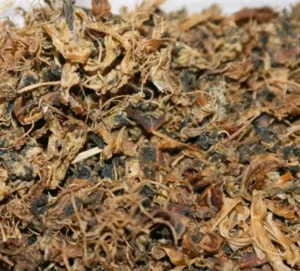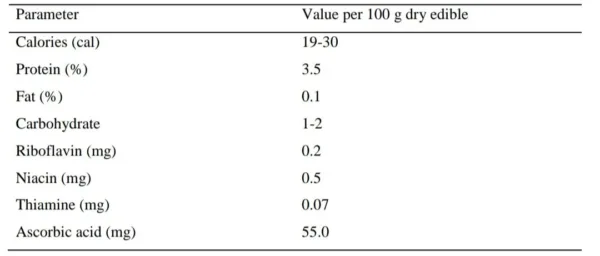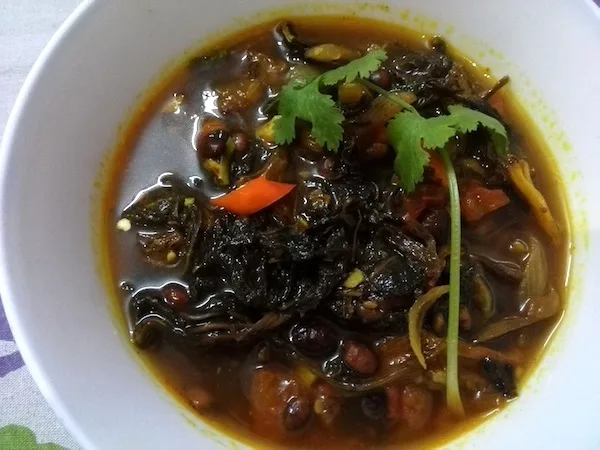Gundruk, a traditional Nepalese dish, holds immense importance in the country’s cuisine and is cherished by Nepalese communities globally. Its distinct characteristics are derived from the fermentation and drying process it undergoes. This versatile food item can be served in various forms, including appetizers, side dishes, or flavorful soups. Particularly in rural areas, it plays a vital role by providing essential minerals during times of vegetable scarcity. It has also gained popularity in the Darjeeling region of India. With its diverse preparation and serving options, Gundruk continues to be celebrated for its unique taste and nutritional benefits.

The Process of Making Gundruk
The process of making Gundruk involves several steps, including fermentation and drying. Below is a detailed explanation of the process:
1. Preparation of Leafy Greens:
Choose an assortment of leafy greens like leafy mustard (rayo sag), mustard leaves, radish leaves, and cauliflower. Thoroughly wash the greens to eliminate any dirt or impurities.
2. Crushing the Greens:
After washing, crush the leafy greens either manually or using a kitchen tool to break them into smaller pieces. This step helps release the juices and initiate the fermentation process.
3. Fermentation:
Take the crushed greens and tightly pack them into a clean, airtight container, ensuring no excess air is trapped inside. The container can be made of food-grade plastic or a traditional vessel like a clay pot.
4. Storage:
Place the container in a dark and warm location, such as a kitchen corner or cupboard. The ideal fermentation temperature is around 20-25 degrees Celsius (68-77 degrees Fahrenheit). Allow the greens to ferment undisturbed for a specific period, typically ranging from a few days to a couple of weeks, depending on personal preference and desired sourness.
5. Checking Fermentation:
Regularly monitor the container during fermentation. Slightly open it to release any accumulated gases or pressure. Taste the greens to determine if they have reached the desired level of sourness. Longer fermentation results in a more pronounced sour flavor.
6. Drying:
Once the desired fermentation level is achieved, remove the fermented greens from the container. Spread them out on clean, dry surfaces such as trays or mats. Allow the greens to air dry in a well-ventilated area, preferably under sunlight. It may take several days for them to completely dry, ensuring prevention of spoilage.
7. Storing Gundruk:
After drying, it is ready for storage. Place the dried greens in airtight containers or plastic bags and store them in a cool, dry place away from moisture and direct sunlight. Properly stored Gundruk can be preserved for an extended period, allowing enjoyment throughout the year.
Specific details of the process may slightly vary depending on regional preferences and individual recipes. However, these steps provide a general overview of how Gundruk is traditionally made through fermentation and drying, resulting in its unique flavor, aroma, and dark brown color.
Fermentation and Drying Process in Gundruk Making
- Gundruk is made by fermenting and drying various leafy greens.
- Crushed leafy vegetables like rayo sag, mustard leaves, radish leaves, and cauliflower are tightly packed into a container.
- The container is then kept in a dark and warm place for fermentation.
- After achieving the desired level of fermentation, the leafy greens are removed and dried in the sun.
- This process gives gundruks its distinct dark brown color and unique characteristics.
Nutritive value of Gundruk
Here’s a table summarizing the nutritional value of Gundruk:
| Nutrient | Value |
| Moisture | 15% |
| pH | 5.0 |
| Acidity | 0.49% |
| Ash | 22.2% |
| Dry Matter (DM) | |
| Protein | 38.7% (DM) |
| Fat | 2.1% (DM) |
| Carbohydrate | 38.3% (DM) |
| Food value | 321.9 kcal/100g (DM) |
| Calcium | 234.6 mg/100g |
| Sodium | 142.2 mg/100g |
| Potassium | 677.6 mg/100g |
Reference: Senapathi, S., Kumari, S., Raj, P. S., & Prajapati, S. (2015). Microbiological and nutritional analysis of gundruk: A traditional fermented leafy vegetable product of Nepal. LWT – Food Science and Technology, 63(2), 799-802.
Chemical composition of Mustard Gundruk

Microbiology of Gundruk
The process of making Gundruk involves microbial fermentation, which plays a crucial role in transforming raw leafy greens into the final product. Here is an overview of the microbiology behind Gundruk:
Natural Microbial Flora:
The initial fermentation of Gundruk relies on the naturally occurring microbial flora on the surface of the leafy greens. These greens harbor various bacteria, yeasts, and molds that initiate the fermentation process.
Lactic Acid Bacteria (LAB):
LAB are the dominant group of microbes responsible for Gundruk’s fermentation. They convert sugars present in the leafy greens into lactic acid through anaerobic fermentation, resulting in the sour taste. Common Lactobacillus species found in Gundruks fermentation include Lactobacillus plantarum, Lactobacillus brevis, and Pediococcus species.
Yeasts:
Yeasts also contribute to fermentation and flavor development. They metabolize sugars, producing ethanol and carbon dioxide as byproducts. This adds to the aroma and effervescence of Gundruk.
Mold Growth:
During the initial stages of Gundruk fermentation, molds such as Aspergillus and Penicillium species may be present. These molds aid in initiating fermentation and contribute to the breakdown of complex compounds in the leafy greens. However, excessive mold growth can lead to undesirable flavors or spoilage, necessitating proper fermentation conditions and control.
Enzyme Activity:
Microbial enzymes produced by LAB, yeasts, and molds during fermentation play a vital role in breaking down complex carbohydrates, proteins, and other components in the leafy greens. This enzymatic activity contributes to the overall transformation of the greens into Gundruk.
Preservation Effect:
Fermentation process in Gundruk not only imparts desired flavor and texture but also acts as a natural preservation method. The acidic environment created by LAB inhibits the growth of pathogenic bacteria, thereby improving the shelf life and safety of the final product.
Microbial composition and fermentation conditions may vary based on regional practices, climate, and specific recipes. Maintaining proper hygiene, temperature control, and fermentation time are essential factors to ensure the production of safe and high-quality Gundruk.
Versatility and Serving Options
Gundruk is a versatile food item that can be enjoyed in various ways:
- Appetizer or Side Dish: Gundruk can be served as an appetizer or a side dish alongside the main meal.
- Flavorful Soups: It is commonly used to prepare delicious and nourishing soups. It can be combined with ingredients like garlic, onions, tomatoes, and chilies. Optionally, potatoes or eggs can be added to enhance the flavor. Gundruk soup is light and summery, aiding in digestion and is often served with rice.
- Spicy Salad: Another popular serving option is to soak it in warm water and sauté it with mustard oil, onions, tomatoes, and chilies, creating a spicy salad.
Gundruk is known for its sour taste, which can be adjusted according to personal preferences. The strong fermented aroma of Gundruk adds to its distinctiveness.
Importance in Rural Areas
Gundruk holds significant importance in rural areas of Nepal for the following reasons:
- Mineral Source: It serves as a valuable source of minerals, fulfilling nutritional needs in regions where vegetables are scarce.
- Seasonal Nutrition: During the off-season when diets primarily consist of starchy tubers and maize, Gundruk provides essential minerals.
- Production Estimate: Household-level production of this food in Nepal is estimated to be around 2,000 tons annually.
Gundruk Beyond Nepal
Gundruk has gained popularity beyond Nepal, particularly in the Darjeeling region of India. In these areas, families use Gundruk to preserve leafy greens when fresh produce is scarce. It serves as a source of greens and dietary fiber, complementing the local cuisine.
Preparation and Serving Suggestions
Gundruk can be prepared and served in various ways to suit different tastes and preferences:
- Thin Soup: It is commonly used to make a thin, watery soup with ingredients like garlic, onions, tomatoes, and chilies. Potatoes or eggs can be added for enhanced flavor. This light and summery soup aids in digestion and is often served with rice.
- Spicy Salad: Another popular option is to sauté Gundruk with mustard oil, onions, tomatoes, and chilies, creating a spicy salad.

It is important to note that these serving suggestions can be adjusted to personal preferences and regional variations.
References
- Ghimire, K. N. (2017). Gundruk – A Traditional Fermented Food of Nepal: A Review. Journal of Ethnic Foods, 4(2), 69-75. doi:10.1016/j.jef.2017.05.001
- Aryal, D., & Kharel, M. K. (2019). The technology and microbiology of Gundruk fermentation: A traditional Nepali fermented leafy vegetable. Food Science & Nutrition, 7(8), 2435-2444. doi:10.1002/fsn3.1049
- Neupane, M. R., & Tamang, J. P. (2005). Ecology and indigenous knowledge in the preservation of ethnic fermented vegetables and bamboo shoots in Nepal. International Journal of Food Microbiology, 99(1), 65-70. doi:10.1016/j.ijfoodmicro.2004.07.004
- Shrestha, P., Chaudhary, P., & Adhikari, D. (2018). Microbiological, physico-chemical and sensory analysis of Gundruk, a traditional fermented leafy vegetable product of Nepal. Food Science & Nutrition, 6(8), 2239-2247. doi:10.1002/fsn3.837
- Adhikari, B. (2013). Gundruk and its potential in Nepal’s food security. Journal of Agriculture and Environment, 14, 26-30. Retrieved from https://www.nepjol.info/index.php/JAE/article/view/
- Pokharel, P. (2018). Thesis. Dharan: Central Campus of Technology, Department of Food Technology. Retrieved from http://202.45.146.37:8080/jspui/handle/123456789/110?mode=full
Learn more: